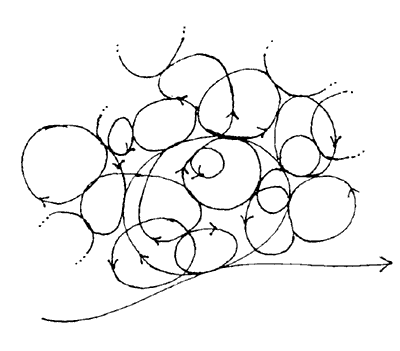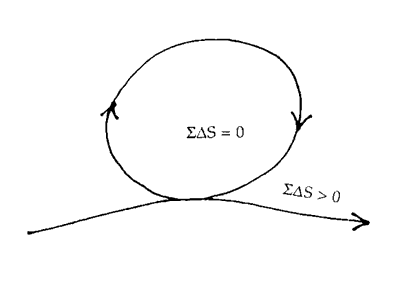Dr. Mae-Wan Ho
Lecture at Schumacher College 10th Anniversary Celebration,
The Prince’s Trust, Charlotte Road, London, April 7, 2001.
Imagine a fire-breathing dragon a mile long flying straight as an arrow across the evening sky. The night goddess, annoyed at the disturbance, casts a silken veil in its path. The head of the dragon hits the veil, but the veil does not rip apart. Instead, the dragon is absorbed into the fabric. In almost no time at all, the entire dragon has vanished, its roar replaced by an eerie silence. The night goddess smiles enigmatically and waits. Then, a slight flicker of her delicate hand, and whuarr! The head of the fiery dragon comes blasting out to continue on its way, but missing the rest of its body. The goddess laughs and flicks the veil again, and out comes the dragon’s trunk. Finally, after another pause, she releases the dragon’s tail. The mighty dragon has been permanently dismembered for violating the peace of the heavens.
I have been describing the remarkable experiment with laser light carried out by US physicist Lene Hau and her colleagues and reported in Nature at the beginning of this year [1]. They show how you can stop light in its tracks. A 2km long laser light-beam, the dragon, can be trapped inside a layer of sodium atoms as thin as a veil, by means of coherent entanglement. The sodium atoms, cooled to near absolute zero and prepared in a coherent state by a coupling laser, slows down the incident laser beam ten million-fold, so that the head hardly has time to emerge before the tail end is completely absorbed. Switching off the coupling laser at this point effectively traps the beam - now squeezed to ten-millionth of its original length - inside the layer. The beam can remain imprisoned for close to a thousandth of a second, which is an eternity on the scale of the speed of light. Switching on the coupling laser will immediately release the light beam to continue on its way. Not only that, by switching the coupling laser on and off three times in succession, the light beam can be released in three separate segments.
This amazing capture of energy by coherent entanglement is what organisms do for a living, day in and day out. Think of coherent entanglement in terms of partners dancing together, perfectly in step, but each doing different movements.
As we face the threats of genetic engineering in the midst of the climate change catastrophe, poet Wendell Berry reminds us, "Thine life is a miracle, think again" [2]. Think again, for it is imperative to replace the destructive, mechanistic and instrumental view of life with the truly organic and miraculous.
James Hillman and Satish Kumar talked about the soul this morning. The soul is the essence of the whole. Organisms are possessed of the irrepressible tendency towards being whole, towards being part of a larger whole. They are predisposed to be soulful. Whole books could be written on the miracle of organisms, and I have written one of them [3], but I won’t have time to talk about that. Instead, I’ll show you some suggestive images of the organism.
It has become a truism that living organisms depend on energy flow. Actually, energy flow is not sufficient; it is energy capture and storage that is key. The sun shines on earth as it does on Mars and Venus, but only earth has life, as far as we know, because only earth has successfully captured and stored the energy of sunlight. The real miracle that enables life to emerge then is to close the energy circle, to make a life cycle that stores and feeds on the energy flowing through. Something magical happens with a circle. A circle entails perpetual return, and that means dynamic stability.
The life cycle is in turn made up of numerous sub-cycles of activities, or biological rhythms, ranging in periods of split seconds and minutes, to circadian, annual and supra-annual (see Figure 1). James Hillman has urged us all to slow down, but also warns against excessive slowing which leads to stagnation. Well, the organism has the full range of activities from the very slow to the very fast all at once, and from the most local to the global. (Just as Schumacher says, we have to pay attention to both the very small as well as the very big, the local and the global.) Each sub-cycle in the diagram is a domain of stored coherent energy. Coherent energy comes and goes together so it can do work, as opposed to incoherent energy that goes in all directions and cancels itself out. You must imagine further, that each sub-domain has an internal structure similar to Figure 1. This ‘self-similarity’ of fractal structures is characteristic of natural processes. All the cycles of activities are linked coherently together; they are dancing together in step but each doing different things at different paces. That is why I can be digesting my breakfast while talking to you and waving my arms about as well.
As you can see, the more sub-cycles there are, the more energy is stored within the system. Cycles make perfect thermodynamic sense. Not only do they give dynamic stability, they enable the activities to be perfectly co-ordinated.

Figure 1. The life-cycle of the organism consists of innumerable, nested and coupled sub-cycles within.
Most importantly, the cycles are linked through all space-time scales in a symmetrical, or reciprocal way, so that processes yielding energy can directly or indirectly transfer the energy to those that require energy, and their roles can be reversed as the need arises. By the same token, energy can be readily transferred from all over the system to any local point and conversely, energy created at any local point can spread over the entire system, with the minimum loss or dissipation. In other words, energy transfer is rapid, efficient and reversible. This creates the conditions for internal balance, so that coherent energy is maximally conserved, and the system organisation is maintained.
All I have said up to now describes the ideal healthy organism, and applies also to a healthy ecosystem, or any sustainable system [4]. Figure 1 explains why sustainable systems are biodiverse, for they maximise energy storage over all space-time scales.
The reciprocal relationships between the activities occurring over the system are the key to dynamic balance and sustainability. You may ask how one can speak of reciprocity when it is always the wolf that devours the lamb. The wolf feeding on the lamb is storing lamb energy, so when the wolf dies and decomposes, it goes to nourish the grass that feeds the sheep that suckles the lamb. One has to think of reciprocities extending over space-times.

Figure 2. The organism consists of cyclic non-dissipative processes coupled to the dissipative one-way energy flow.
Now, let me show you some images of real organisms (see them here). These are live organisms (the fruitfly larva, daphnia and the brine shrimp) recorded on video camera with an imaging technique invented in my laboratory, which enables us to see them in all the colours of the rainbow. The technique is a slight modification of the polarised light microscopy routinely used by earth scientists to look at rock crystals and more recently, also liquid crystals. But crystals have static molecular order, so how can living, moving organisms appear crystalline? All the molecules in the body would be moving around transforming and transferring energy.
The answer is that the molecules must be moving coherently together. Because the coherent motions are much slower than the vibrations of light, the molecules appear static to the light passing through. It is like capturing a still photograph of a moving object with a very fast film. In fact, these images directly demonstrate that highly coherent molecular motions must be taking place in the organisms’ body. The organism is thick with coherent activities over all scales, from the molecular to the macroscopic. There is no preferred level within the organism. All the parts are participating in the whole.
These images also show that how we observe determines what we observe. As someone said, if your only tool is a hammer, then everything looks like a nail. Mechanistic biology is like a hammer, so everything looks dead as nails, or as Brian Goodwin said, like nuts and bolts. If we observe with the sensitivity of organisms, however, we see them as organisms. Our imaging technique is non-destructive, if not non-invasive. You can put the organisms back into the aquarium afterwards.
I would like to draw out some of the main lessons the organism teaches us about the organic whole as opposed to the mechanistic whole. The organic whole is an ideal democracy of distributed control. It does not work in terms of a hierarchy of controller versus the controlled, but by intercommunication. Ultimately, each is as much in control as it is sensitive and responsive. In the ideal coherent system, local freedom (or autonomy) and global cohesion are both maximised. That is impossible within a mechanical system where public and private, local and global, are always in conflict.
Most important of all, the organic whole is quintessentially diverse and pluralistic. The organism is the antithesis of uniformity and homogeneity. We have some 30 000 genes and 300 000 proteins, astronomical numbers of metabolites, cofactors, inorganic ions, in numerous kinds of cells, tissues and organs that make up our body, all of which are necessary for sustaining the whole. In the same way, populations are naturally diverse, and thriving ecosystems are rich in species.
As hundreds of indigenous tribes today are being driven to extinction by the activities of corporations engaged in mining, timbering and oil extraction, I must stress in the strongest terms that we need the diversity of cultures in the human species. We need the full diversity of cultures to sustain the human miracle, to express the full creative human potential.
Article first published 10/04/01
Got something to say about this page? Comment